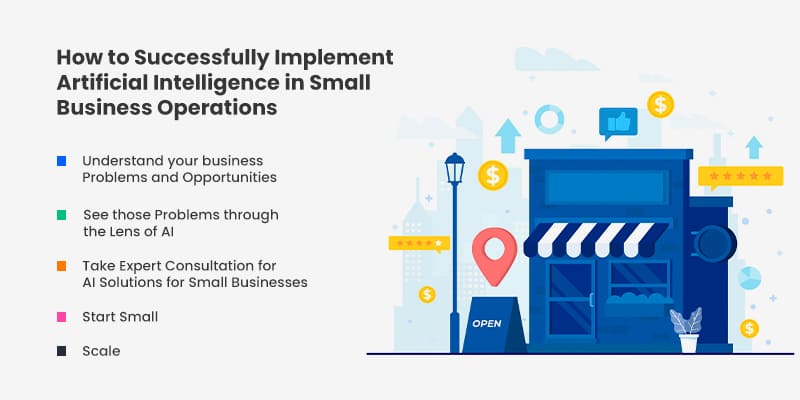
Unlocking Growth: How to Implement AI in Your Small Business (Even on a Budget!)
In today’s fast-paced business world, Artificial Intelligence (AI) isn’t just a futuristic concept reserved for tech giants. It’s a powerful, accessible tool that can revolutionize how small businesses operate, compete, and grow. If you’ve been wondering how to harness the power of AI without a massive budget or a team of data scientists, you’re in the right place.
This comprehensive guide will break down the "how-to" of AI implementation for small businesses, making it easy to understand and actionable, even if you’re a complete beginner. Get ready to discover how AI can boost your efficiency, delight your customers, and give you a significant competitive edge.
Beyond the Hype: Why Small Businesses Need AI Now
Forget the images of sci-fi robots. Modern AI is about smart software that automates tasks, analyzes data, and provides insights, often integrated into tools you might already use. For small businesses, the benefits are immense and often critical for survival and growth:
- Boosted Efficiency & Productivity: AI can take over repetitive, time-consuming tasks, freeing up your team to focus on strategic work, creativity, and customer relationships. Think data entry, scheduling, or even basic content generation.
- Enhanced Customer Experience: AI-powered tools can provide 24/7 support, personalize interactions, and quickly resolve common queries, leading to happier, more loyal customers.
- Cost Savings: By automating tasks and optimizing processes, AI can reduce operational costs, minimize errors, and make your existing resources go further.
- Competitive Edge: While your competitors might be hesitant, adopting AI can position your small business as forward-thinking, innovative, and highly efficient, attracting more customers and talent.
- Smarter Decision-Making: AI can analyze vast amounts of data in seconds, identifying trends, predicting outcomes, and offering actionable insights that would be impossible for humans to uncover manually.
Dispelling Myths: AI Isn’t Just for Tech Giants
Before we dive into implementation, let’s address some common misconceptions that might be holding you back:
- Myth 1: AI is too expensive. Many powerful AI tools are now available on a subscription basis, with free tiers or affordable plans designed specifically for small businesses.
- Myth 2: AI is too complex to implement. You don’t need to code! Most AI tools are user-friendly, with intuitive interfaces and plug-and-play functionality.
- Myth 3: AI will replace human jobs. AI is a tool designed to augment human capabilities, not replace them. It handles the mundane, allowing your team to excel at what they do best.
- Myth 4: My business is too small for AI. AI thrives on data, no matter the scale. Even a small amount of data can yield valuable insights and automation opportunities.
Your AI Implementation Roadmap: A Step-by-Step Guide
Implementing AI in your small business doesn’t have to be overwhelming. Follow this structured approach to ensure a smooth and successful integration.
Step 1: Pinpoint Your Pain Points and Opportunities
Before you even think about tools, identify where AI can make the biggest difference in your business.
- What are your most repetitive tasks? (e.g., answering common customer questions, scheduling appointments, generating social media captions, data entry).
- Where are you losing time or money? (e.g., inefficient marketing, slow customer service, manual invoicing errors).
- What areas could benefit from better insights? (e.g., understanding customer behavior, predicting sales trends, optimizing inventory).
- Where do your customers experience friction? (e.g., long wait times for support, difficulty finding information).
Action: Make a list of 3-5 specific areas where you believe AI could offer immediate value. Prioritize the one with the highest potential impact and the lowest barrier to entry.
Step 2: Start Small, Think Big (and Practical)
Don’t try to overhaul your entire business with AI at once. Begin with a single, well-defined project. This "proof of concept" approach allows you to learn, adapt, and demonstrate value quickly.
Examples of "Starting Small":
- Implement a simple chatbot on your website to answer FAQs.
- Use an AI writing assistant for your social media posts or blog outlines.
- Automate lead qualification with an AI-powered CRM feature.
- Set up AI-driven email sorting to prioritize important messages.
Action: Choose one specific pain point from Step 1 and define a clear, measurable goal for your first AI project. (e.g., "Reduce customer service email volume by 20% using a chatbot.")
Step 3: Explore Accessible AI Tools for Small Businesses
The market is flooded with user-friendly AI tools designed for non-technical users. Here are common categories and examples of what they can do:
A. Customer Service & Support
- AI Chatbots: Provide instant answers to common questions on your website or social media.
- Benefits: 24/7 availability, reduced workload for staff, faster responses.
- Examples: Many website builders (like Wix, Squarespace, Shopify) offer integrated chatbot features; dedicated tools like Tidio, LiveChat, or even using ChatGPT for generating responses.
- AI-Powered CRMs (Customer Relationship Management): Automate lead scoring, personalize customer interactions, and predict customer needs.
- Benefits: Improved sales efficiency, deeper customer understanding, personalized outreach.
- Examples: HubSpot, Salesforce Essentials, Zoho CRM often include AI features.
B. Marketing & Sales
- AI Content Generation: Help brainstorm ideas, write headlines, create social media posts, or draft blog outlines.
- Benefits: Save time on content creation, overcome writer’s block, generate diverse ideas.
- Examples: ChatGPT, Jasper, Copy.ai, Grammarly (for advanced writing suggestions).
- AI for Personalization: Tailor email campaigns, website experiences, or product recommendations based on user behavior.
- Benefits: Higher conversion rates, more relevant customer experiences.
- Examples: Mailchimp, ActiveCampaign often have AI-driven segmentation and personalization features.
- AI for Ad Optimization: Analyze ad performance and suggest improvements for better targeting and ROI.
- Benefits: Maximized ad spend, reaching the right audience.
- Examples: Google Ads and Facebook Ads platforms have built-in AI for optimization.
C. Operations & Productivity
- AI for Task Automation: Connect different apps to automate workflows (e.g., when a new lead comes in, automatically add them to your email list and send a welcome email).
- Benefits: Eliminate manual busywork, reduce errors, save countless hours.
- Examples: Zapier, Make (formerly Integromat) are powerful automation platforms that can integrate AI actions.
- AI Scheduling Assistants: Help manage appointments and optimize calendars.
- Benefits: Fewer scheduling conflicts, professional booking experience.
- Examples: Calendly, Acuity Scheduling, and some virtual assistant services use AI.
- AI for Data Analysis & Reporting: Quickly process large datasets to identify trends, create summaries, and generate reports.
- Benefits: Faster, more accurate insights for decision-making.
- Examples: Microsoft Excel (with its "Ideas" feature), Google Sheets (with "Explore"), specialized business intelligence tools.
D. Financial Management
- AI for Expense Tracking & Categorization: Automate the classification of expenses.
- Benefits: Saves time, improves accuracy for tax purposes.
- Examples: QuickBooks, Xero often have AI features for this.
- AI for Fraud Detection: Flag suspicious transactions or patterns.
- Benefits: Protects your business from financial loss.
- Examples: Many banking and payment processing services incorporate AI for security.
Action: Research 2-3 tools that fit your chosen pain point and budget. Look for free trials or demos to test them out.
Step 4: Pilot, Test, and Learn
Don’t just launch your AI solution company-wide. Implement it in a controlled environment first.
- Small Scale Deployment: Roll it out to a small team, a specific customer segment, or a limited part of your website.
- Gather Feedback: Actively collect feedback from users (employees and customers). What’s working? What’s confusing? Where are the gaps?
- Monitor Performance: Track the metrics related to your initial goal (e.g., chatbot response rate, time saved on content creation, lead conversion rates).
- Iterate: Use the feedback and data to refine the AI tool’s settings, content, or integration. AI often performs best with ongoing training and adjustments.
Action: Implement your chosen AI tool on a small scale, set a testing period (e.g., 2-4 weeks), and establish clear metrics for success.
Step 5: Empower Your Team Through Training
Your team is your greatest asset, and their adoption of AI is crucial. Don’t just spring new tools on them.
- Communicate the "Why": Explain how AI will benefit them (e.g., reducing tedious tasks, allowing more time for creative work, improving customer satisfaction).
- Provide Simple Training: Offer hands-on sessions, clear instructions, and readily available support. Focus on practical "how-to" scenarios.
- Address Concerns: Be open to questions and address any fears about job security. Emphasize that AI is a helper, not a replacement.
- Lead by Example: Show your own enthusiasm for the new tools and demonstrate how they can be used effectively.
Action: Develop a simple training plan for your team, focusing on the practical benefits and how to use the specific AI tool.
Step 6: Measure, Refine, and Scale
Once your pilot project is successful, it’s time to analyze the results and consider scaling up.
- Review Your Goals: Did you meet your initial objective? What were the unexpected benefits or challenges?
- Calculate ROI: Even if it’s not strictly financial, quantify the time saved, customer satisfaction improved, or errors reduced.
- Look for New Opportunities: Based on your success, where else can AI be applied in your business?
- Consider Scaling: If the initial implementation was successful, expand its use to other departments or customer segments. Continue to monitor and refine.
Action: Regularly review the performance of your AI tools. Be prepared to adapt and look for the next logical AI integration point in your business.
Important Considerations for Your AI Journey
While exciting, implementing AI also requires careful thought about a few critical aspects:
- Data Quality: AI models are only as good as the data they’re trained on. Ensure your data is clean, accurate, and relevant. "Garbage in, garbage out" applies here.
- Privacy and Security: Be mindful of customer data privacy (GDPR, CCPA, etc.) and ensure any AI tools you use comply with regulations. Prioritize tools with robust security features.
- Ethical AI Use: Avoid using AI in ways that could lead to discrimination, bias, or misleading information. Always maintain human oversight and accountability.
- Human Oversight is Key: AI is a powerful tool, but it’s not infallible. Always have a human in the loop to review AI-generated content, customer interactions, or data insights.
- Start Small, Stay Agile: The AI landscape is evolving rapidly. Be prepared to learn, experiment, and adapt your strategy as new tools and capabilities emerge.
- Budget Wisely: While many tools are affordable, factor in subscription costs, potential training expenses, and any integration fees into your overall budget.
Embrace the Future: Don’t Get Left Behind
The future of business is intertwined with AI. Small businesses that embrace this technology now, even in a limited capacity, will be better positioned to compete, innovate, and thrive. You don’t need a massive budget or a tech background to start.
By identifying your pain points, starting small with accessible tools, empowering your team, and continuously refining your approach, you can successfully implement AI in your small business and unlock a new era of growth and efficiency. The journey begins with a single step – what will yours be?



Post Comment